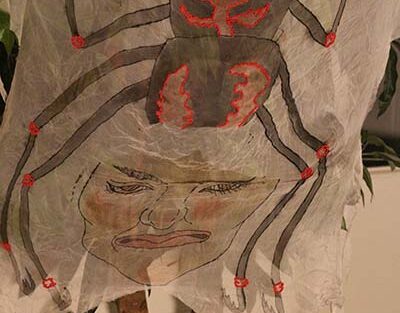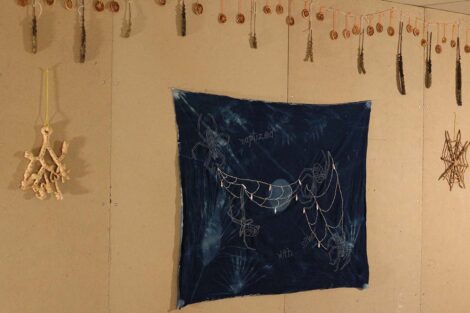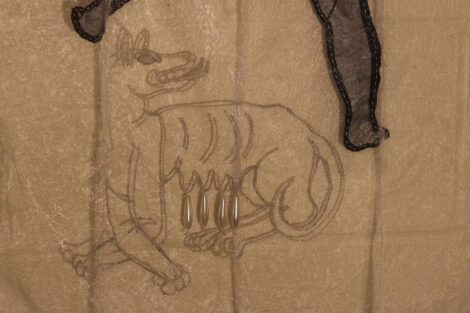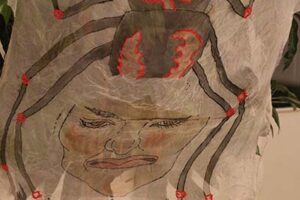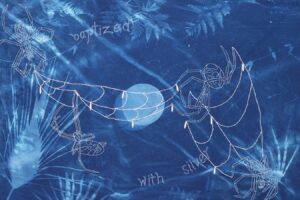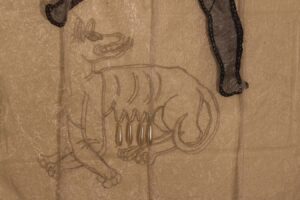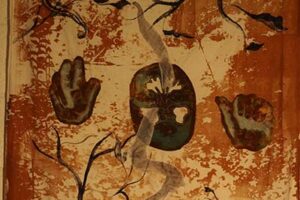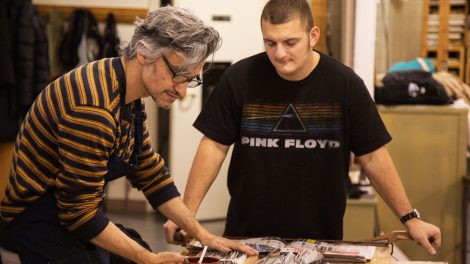Yale School of Art graduate finds inspiration working with Lafayette students: “Being here has helped me reevaluate my life, where I want to live and where I want to teach"
By Stephen Wilson
When walking into the cloistered studio space tucked in a building behind Buck Hall on the downtown Williams Arts Campus, you are greeted by a spider. Painted on silk and draped over a plant, the spider is one of many mythical and mystical elements on display in the opening room.
Hag torches of dried mullein and beeswax hang on the wall with a webbing of dried lemon slices, objects of cleansing and protection.
This artwork prepares viewers for a kitchenette and bathroom activated with more personal, profound, and profane work by Krystal DiFronzo, Experimental Printmaking Institute (EPI) artist in residence.

Krystal DiFronzo, Experimental Printmaking Institute’s artist in residence
The residency, conceived by Pedro Barbeito, assistant professor of art and director of EPI, is a collaborative effort between the College and Yale School of Art. DiFronzo graduated with her MFA in June 2020. Her fall 2020 residency was postponed a year due to COVID. But this semester has been fruitful both in her work and life as well as the classroom.
DiFronzo has taught an introduction to printmaking class and was a visiting critic with Barbeito’s capstone course for senior art majors.
Working at both ends of the spectrum have had her navigate a range of artistic development.
“The seniors have refined ideas and a language for art and their work,” she says. “The introductory students are attempting to develop concepts and not just translate or replicate pieces they like.”
DiFronzo has been inspired by the interdisciplinary nature of the student work, citing one project where detailed data on fracking was reinterpreted into a zine. It makes her think that liberal arts colleges might be more intriguing for a career in teaching than an arts institution.
“I have students majoring in fields like engineering, art history, and environmental studies that are new to printmaking but bring a fascinating and unique view through their other studies,” she says.
DiFronzo demands rigor in order to make students see images in a new way as well as expand their language and techniques for creating serious work.
She would know. A diagnosis of Hodgkin lymphoma dramatically altered her work, making it more personal as she wrestled with the idea of her own cells exerting their own free will. Her body became a vessel for life and art.
She tapped into her experiences—her wig-making mother, bodybuilding father, youth in the sprawl of Chicago and swamps of Florida.
DiFronzo works in ink, paint, textile, and print. Most is crafted, as in homemade where she dyes wools, sews by hand kneads bread dough, and gathers plants and roots.
Her time in Easton has been ripe as she hiked local trails and explored the Delaware River and its history of feeding and flooding the valley, meeting an eel trapper and incorporating the native species into her work.
“Being here has helped me reevaluate my life, where I want to live and where I want to teach,” she says.
That’s visible in the kitchenette in her studio, which feels very feminine. Wig hair is draped off shelves where jars of naturally collected dyes, like madder root and black walnut, sit. Muslin bags, cut and restitched, serve as the backdrop for a piece that incorporates images of her form, a moon, and she-wolf. A print of the Delaware River and eels hangs on another wall.
It’s clear DiFronzo has found her elements here.

